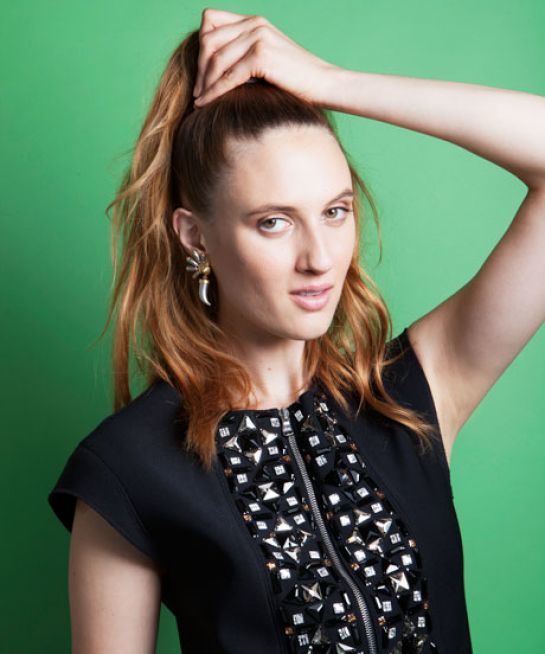
There’s a reason all the girls in L.A. go for highlights — single-process color is striking, but those ribbons of lightness do so much for your complexion. Highlights can accentuate eye color, bring out cheek bones, and even slim faces. They show off the lines of your hair cut, create depth and the illusion of fullness. They are a great introduction to hair color — and, despite what you’ve heard, they work for all hues.
Ahead, you’ll learn about some of the most important factors to achieving a perfect highlight: size, placement, amount, and lightness level. With the right colorist and technique, you’ll get the streaks you want in no time.
The two most common techniques used for highlighting are balayage (freehand painting), and foil. Different artists will use one or the other depending on the desired look and their personal preference. But a skilled colorist can achieve any look using either technique.
How Light Should You Go?
First things first. The level of lightness of your highlights is determined by the strength of the lightener, and how long it's left on the hair. For the most natural look, highlights shouldn't be more than two to three levels lighter than the base color, and they should be in the same tonal family. In other words, if the base is warm (dark, golden blonde), the highlights should be warm (buttery blonde). If the base is a cool, sandy blonde, then the highlights should be in the cool family as well, like a light beige.
Of course, the color you choose is up to you, but there are some general guidelines for achieving the most flattering hue for your complexion. f you have pink undertones, then you might want to avoid having warmth in your highlights. It will make you look flushed in the same way that wearing a red shirt would. Check the veins in your arms: If you have green veins and gold flecks in your eyes, then you're a warm skin tone. You should generally opt for cool tones like sandy blondes, and beige blondes.
If you have an olive skin tone, blue veins, and silver-grey flecks in your eyes, then golden blonde tones will bring warmth to your face, and make your skin appear less green. Try buttery blondes, honey, and strawberry.
If your skin tone is neutral and has no pink or green, then (lucky you!) you can go for either warm or cool blonde hues.
Think About Placement And Size
The thickest and lightest pieces should be around the frame of the face. They should then regress in size and lightness toward the crown. The tighter you weave the highlights and the closer together you place them, the lighter the overall look will be, and the less contrast you'll have.
Foils
If you're a perfectionist who likes total balance and symmetry, then this technique is for you. Foils involve weaving strands of hair and painting a lightning agent on them before wrapping them in foil. The foil keeps the product moist, and the strength doesn't weaken. The foils can be placed in different patterns depending on where the hair is parted, and how it's worn. You can foil with hair dye, oil bleaches, and many other gentle products. You know exactly where everything is placed, as well as the size and lightness of each foil.
Balayage
Balayage is the French word for "to sweep," and it refers to the sweeping motion the brush makes when painting bleach on to the hair. This technique involves carving out swatches of hair in revolutions around the head. The bleach is painted freehand, directly on the hair, and covered with cellophane. Because the bleach is exposed to the air, it weakens quickly (in the same way a bottle of Clorox would weaken if you left the cap off), so it's necessary to use high strengths of lighteners. Also, it results in a much less systematic and more haphazard look then foil, and is best used for edgy, beachy looks like surfer-chic highlights and ombré.
Hygge
This Danish-inspired color trend has taken over L.A. The highlighting technique is a variation of balayage — adding warmth and dimension to singular-toned hair by infusing soft coppers, amber-based oranges and faint blonds.
Lowlights
Lowlights refers to strands of darkness woven back into the hair to return contrast to hair that's been highlighted repeatedly. They are usually the same level of darkness as the base color (or within a shade or two) and they can be used to bridge the gap between a very dark base color that has very light highlights.
By weaving an in-between shade of lowlight, you can connect the two other colors and avoid looking stripy. It's important to periodically check with your colorist to see if you need to weave in a few lowlights. You never want your skin tone to match you hair color, so prevent looking washed out by doing lowlights when necessary.
Babylights
Babylights are soft, fine highlights that are placed around the hairline. "With babylights, you can add a shimmer of color if you scatter them throughout — or, if you do it all over the head, it’s super delicate," says stylist Jack Howard of London's Paul Edmonds salon. "It’s so fine, it looks like you were born with it.”
Sombré
For darker hair, try sombré. “Low-maintenance color has been a trend for a while and has now been amplified with sombré, a subtler and blended take on ombré,” says colorist Tracey Cunningham. “Sombré is a softer, more wearable and natural, look that is flattering on everyone, but especially brunettes.”
For the brunette looking for some natural-looking warmth, we suggest screengrabbing this soft look as inspiration.
Pintura
Curly girls, rejoice! Over 20 years ago, Devachan Salon came up with this technique meant for textured hair. A colorist hand paints curls without using foils. Once they identify the strands that catch the most light, more dimension is added.
See? This color is a work of art.